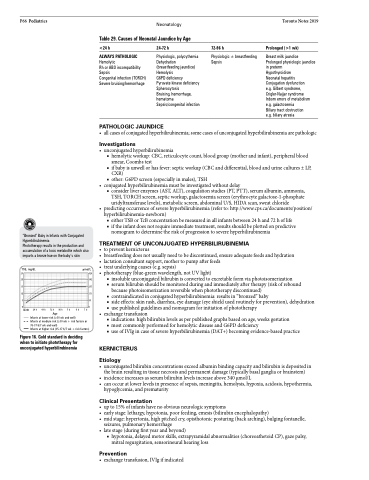Page 1100 - TNFlipTest
P. 1100
P66 Pediatrics
Neonatology
Toronto Notes 2019
Table 29. Causes of Neonatal Jaundice by Age
<24 h
ALWAYS PATHOLOGIC
Hemolytic
Rh or ABO incompatibility Sepsis
Congenital infection (TORCH) Severe bruising/hemorrhage
24-72 h
72-96 h
Prolonged (>1 wk)
Breast milk jaundice Prolonged physiologic jaundice in preterm
Hypothyroidism
Neonatal hepatitis
Conjugation dysfunction
e.g. Gilbert syndrome, Crigler-Najjar syndrome
Inborn errors of metabolism e.g. galactosemia
Biliary tract obstruction
e.g. biliary atresia
Physiologic, polycythemia
Dehydration Sepsis (breastfeeding jaundice)
Hemolysis
G6PD deficiency
Pyruvate kinase deficiency Spherocytosis
Bruising, hemorrhage,
hematoma
Sepsis/congenital infection
Physiologic ± breastfeeding
“Bronzed” Baby in Infants with Conjugated Hyperbilirubinemia
Phototherapy results in the production and accumulation of a toxic metabolite which also imparts a bronze hue on the baby’s skin
TSB, mg/dL μmol/L 25 428
20 342 15 257 10 171 5 85
00
• allcasesofconjugatedhyperbilirubinemia;somecasesofunconjugatedhyperbilirubinemiaarepathologic
Investigations
• unconjugatedhyperbilirubinemia
■ hemolytic workup: CBC, reticulocyte count, blood group (mother and infant), peripheral blood
smear, Coombs test
■ if baby is unwell or has fever: septic workup (CBC and differential, blood and urine cultures ± LP,
CXR)
■ other: G6PD screen (especially in males), TSH
• conjugatedhyperbilirubinemiamustbeinvestigatedwithoutdelay
■ consider liver enzymes (AST, ALT), coagulation studies (PT, PTT), serum albumin, ammonia,
TSH, TORCH screen, septic workup, galactosemia screen (erythrocyte galactose-1-phosphate
uridyltransferase levels), metabolic screen, abdominal U/S, HIDA scan, sweat chloride
• predictingoccurrenceofseverehyperbilirubinemia(referto:http://www.cps.ca/documents/position/
hyperbilirubinemia-newborn)
■ either TSB or TcB concentration be measured in all infants between 24 h and 72 h of life
■ if the infant does not require immediate treatment, results should be plotted on predictive
nomogram to determine the risk of progression to severe hyperbilirubinemia
TREATMENT OF UNCONJUGATED HYPERBILIRUBINEMIA
• topreventkernicterus
• breastfeedingdoesnotusuallyneedtobediscontinued,ensureadequatefeedsandhydration • lactationconsultantsupport,mothertopumpafterfeeds
• treatunderlyingcauses(e.g.sepsis)
• phototherapy(blue-greenwavelength,notUVlight)
■ insoluble unconjugated bilirubin is converted to excretable form via photoisomerization
■ serum bilirubin should be monitored during and immediately after therapy (risk of rebound
because photoisomerization reversible when phototherapy discontinued)
■ contraindicated in conjugated hyperbilirubinemia: results in “bronzed” baby
■ side effects: skin rash, diarrhea, eye damage (eye shield used routinely for prevention), dehydration ■ use published guidelines and nomogram for initiation of phototherapy
• exchangetransfusion
■ indications: high bilirubin levels as per published graphs based on age, weeks gestation
■ most commonly performed for hemolytic disease and G6PD deficiency
■ use of IVIg in case of severe hyperbilirubinemia (DAT+) becoming evidence-based practice
KERNICTERUS
Etiology
• unconjugatedbilirubinconcentrationsexceedalbuminbindingcapacityandbilirubinisdepositedin the brain resulting in tissue necrosis and permanent damage (typically basal ganglia or brainstem)
• incidenceincreasesasserumbilirubinlevelsincreaseabove340μmol/L
• canoccuratlowerlevelsinpresenceofsepsis,meningitis,hemolysis,hypoxia,acidosis,hypothermia,
hypoglycemia, and prematurity
Clinical Presentation
• upto15%ofinfantshavenoobviousneurologicsymptoms
• earlystage:lethargy,hypotonia,poorfeeding,emesis(bilirubinencephalopathy)
• midstage:hypertonia,highpitchedcry,opisthotonicposturing(backarching),bulgingfontanelle,
seizures, pulmonary hemorrhage
• latestage(duringfirstyearandbeyond)
■ hypotonia, delayed motor skills, extrapyramidal abnormalities (choreoathetoid CP), gaze palsy, mitral regurgitation, sensorineural hearing loss
Prevention
• exchangetransfusion,IVIgifindicated
PATHOLOGIC JAUNDICE
Birth
24 h 48 h 72 h 96 h 5 d 6 d 7 d Age
Infants at lower risk (≥38 wk and well)
Infants at medium risk (≥38 wk + risk factors or 35-37 6/7 wk and well)
Infants at higher risk (35-37 6/7 wk + risk factors)
Figure 16. Gold standard in deciding when to initiate phototherapy for unconjugated hyperbilirubinemia


